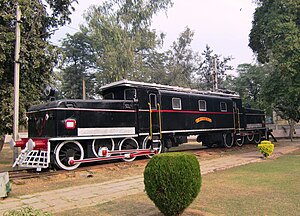GIPR class EF / 1
| GIPR EF / 1 IR WCG-1 |
|
|---|---|
|
Locomotive GIPR 4502 in the National Rail Museum of India
|
|
| Numbering: | GIPR 4500-4540 IR 20027-20067 |
| Number: | 41 |
| Manufacturer: |
Mechanical part: SLM 10 pieces Serial numbers: 3195–3204 Vulcan Foundry 31 pieces Serial numbers: 4048–4078 Electrical part: Metrovick under license from BBC |
| Year of construction (s): | 1928-1929 |
| Retirement: | approx. 2000 |
| Axis formula : | C'C ' |
| Gauge : | 1676 mm |
| Length over buffers: | 66 ft 1 in (20,142 mm) |
| Bogie axle base: | 15 ft 1 in (4,596 mm) |
| Total wheelbase: | 54 ft 11 in (16,738 mm) |
| Service mass: | 123 t |
| Wheel set mass : | 20.5 t |
| Top speed: | 45 mph (72 km / h) |
| Hourly output : | 2600 hp (1.9 MW) |
| Starting tractive effort: | 67,200 lbs (300 kN) coefficient of friction: 25% |
| Hourly traction: | 56,000 lbs (250 kN) at 33 km / h |
| Continuous tensile force: | 40,000 lbs (178 kN) at 29 km / h |
| Driving wheel diameter: | 4 ft (1220 mm) |
| Power system : | 1500 V DC |
| Number of traction motors: | 4 × 650 PS (478 kW) |
| Drive: | SLM helical rod drive |
| Brake: | Vacuum brake |
| Locomotive brake: | Direct brake , vacuum controlled air brake, regenerative brake |
The class EF / 1 electric locomotives of the Great Indian Peninsula Railway (GIPR), later WCG-1 of the Indian Railways (IR), were used in freight train service on the lines electrified with 1500 V direct current . The locomotives belong to the family of crocodile locomotives .
construction
The locomotives were ordered in 1926. The mechanical part of the first 10 locomotives was built by SLM in Winterthur , the remaining 31 at Vulcan Foundry in Newton-le-Willows . The electrical part of all 41 locomotives was built by Metrovick based on drawings by BBC from Baden AG .
These were the first electric locomotives built by Vulcan Foundry.
technology
The total weight of the locomotive was 123 t, of which 72.25 t was accounted for by the mechanical part and 50.75 t by the electrical part.
Mechanical part
The locomotive has two bogies with three coupled axles that were driven by an SLM helical rod drive. The drive axle was the third axle in the bogie, the drive was carried out by a double drive motor via a jackshaft, which is arranged between axles 1 and 2, on the driving and coupling rods.
The two motor bogies, on which the pulling and pushing devices were also attached, had low structures in which the traction motors and the reversing switch were housed. The locomotive body with the two driver's cabs connected the two motor bogies. The locomotive could negotiate arcs with a radius of 500 ft (152 m).
Brake and pneumatic equipment
The locomotive was equipped with a vacuum brake for the train, whereby the brake of the locomotive itself was designed as a vacuum-controlled air brake . There were two vacuum pumps and two piston compressors , with the compressors being driven by 1500 V motors directly supplied with overhead line voltage. The sand spreaders , which work with compressed air, could be operated via a pedal . The pantographs could be raised and lowered using a manually operated compressed air valve. A compressed air whistle was available as an acoustic warning device.
Electrical part
The 650 hp traction motors were designed for 1500 V windings . The following groupings were possible:
- all four motors in series
- two motors connected in series parallel to the other two motors connected in series
- all traction motors in parallel
The electro-pneumatic control had nine speed levels - three in each group.
There was also an electric regenerative brake that worked in the speed range from 8 mph (12.8 m / h) to 35 mph (56 km / h). The excitation of the traction motors was ensured by an axle generator.
business
The locomotives were used both in front of freight trains on the GIPR routes Bombay - Pune and Bombay - Igatpuri , but also had the task of pushing trains on the up to 30 ‰ steep Bhor Ghat ramp . They were referred to by the staff as खेकडा [ Khēka deutschā ], German for ' crab ' , and proved their worth on the mountain route with their good cornering ability . It is often mentioned that the locomotives made a strange groaning noise when standing and made a whisking noise when driving, which was typical of most crocodile locomotives.
From 1974 the WCG-1 were only used in shunting services in Bombay and Lonavla , where the last locomotives were spotted in action in 1992. In Bombay they were based in the Wadi Bunder depot near the Bombay Victoria Terminus and were mainly used to assemble passenger trains.
The first locomotive was named Sir Leslie Wilson , who was Governor of Bombay from 1923 to 1928 . The nameplate is now on locomotive No. 4502 on display at the National Rail Museum of India .
literature
- 2,600 HP 0-6-6-0 Electric Freight Locomotive, Great Indian Peninsula Railway . In: Vulcan Foundry (ed.): Vulcan Locomotives . ( pdf ).
Individual evidence
- ^ Vulcan Foundry Diesel & Electric Photographic Loco List. In: The Vulcan Foundry Newton-le-Willows. Retrieved January 1, 2018 .
- ↑ a b c Vulcan Locomotives
- ↑ a b India Railways - Class WCG-1 electric locomotive No. 20042 in 1968 . In: Flickr . ( flickr.com [accessed January 1, 2018]).


